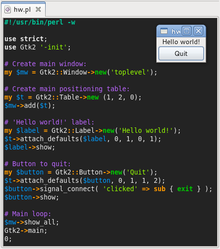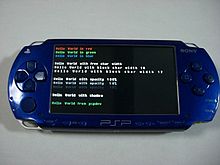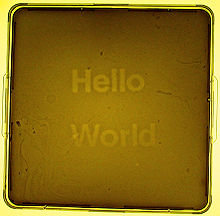- Hello world program
-
"Hello World" redirects here. For the 2009 compilation album by Michael Jackson, see Hello World: The Motown Solo Collection. For the song by Lady Antebellum, see Hello World (song).
A "Hello world" program is a computer program that prints out "Hello world" on a display device. Because it is typically one of the simplest programs possible in most programming languages, it is by tradition often used to illustrate to beginners the most basic syntax of a programming language, or to verify that a language or system is operating correctly.
In a device that does not display text, a simple program to produce a signal, such as turning on an LED, is often substituted for "Hello world" as the introductory program.
Contents
Purpose
A "hello world" program has become the traditional first program that many people learn. In general, it is simple enough that people who have no experience with computer programming can easily understand it, especially with the guidance of a teacher or a written guide. Using this simple program as a basis, computer science principles or elements of a specific programming language can be explained to novice programmers. Experienced programmers learning new languages can also gain a lot of information about a given language's syntax and structure from a hello world program.
In addition, hello world can be a useful sanity test to make sure that a language's compiler, development environment, and run-time environment are correctly installed. Configuring a complete programming toolchain from scratch to the point where even trivial programs can be compiled and run can involve substantial amounts of work. For this reason, a simple program is used first when testing a new tool chain.
"Hello world" is also used by computer hackers as a proof of concept that arbitrary code can be executed through an exploit where the system designers did not intend code to be executed—for example, on Sony's PlayStation Portable. This is the first step in using homemade content ("home brew") on such a device.
History
While small test programs existed since the development of programmable computers, the tradition of using the phrase "Hello world!" as a test message was influenced by an example program in the seminal book The C Programming Language. The example program from that book prints "
hello, world" (without capital letters or exclamation mark), and was inherited from a 1974 Bell Laboratories internal memorandum by Brian Kernighan, Programming in C: A Tutorial, which contains the first known version:main() { printf("hello, world\n"); }
The first known instance of the usage of the words "hello" and "world" together in computer literature occurred earlier, in Kernighan's 1972 Tutorial Introduction to the Language B,[1] with the following code:
main( ) { extrn a, b, c; putchar(a); putchar(b); putchar(c); putchar('!*n'); } a 'hell'; b 'o, w'; c 'orld';
For modern languages, the hello world program tends to subtly grow in sophistication. For example, the Go programming language introduced a multilingual hello world program,[2] Sun demonstrated a Java hello world based on scalable vector graphics,[3] and the XL programming language features a spinning Earth hello world using 3D graphics.[4] Wikipedia founder Jimmy Wales announced during his presentation in Tuscaloosa's Ferguson Center Theater on September 2010 that Wikipedia's first live page was a 'Hello World' page.[citation needed]
Variations
There are many variations on the punctuation and casing of the phrase. Variations include the presence or absence of the comma and exclamation mark, and the capitalization of the 'H', both the 'H' and the 'W', or neither. Some languages are forced to implement different forms, such as "
HELLO WORLD!", on systems that only support capital letters, while many "hello world" programs in esoteric languages print out a slightly modified string. For example, the first non-trivial Malbolge program printed "HEllO WORld", this having been determined to be good enough.There are variations in spirit, as well. Functional programming languages, like Lisp, ML and Haskell, tend to substitute a factorial program for Hello World, as the former emphasizes recursive techniques, which are a large part of functional programming, while the latter emphasizes I/O, which violates the spirit of pure functional programming by producing side effects.
The Debian and Ubuntu Linux distributions provide the "hello world" program through the apt packaging system; this allows users to simply type "apt-get install hello" for the program to be installed, along with any software dependencies. While of itself useless, it serves as a sanity check and a simple example to newcomers of how to install a package. It is significantly more useful for developers, however, as it provides an example of how to create a .deb package, either traditionally or using debhelper, and the version of hello used, GNU hello, serves as an example of how to write a GNU program.[5]
See also
- "99 Bottles Of Beer" as used in computer science
- Foobar
- Hello world program examples
- Just another Perl hacker
- List of basic computer science topics
- Trabb Pardo-Knuth algorithm
- At Wikibooks:
References
- ^ "The Programming Language B". http://cm.bell-labs.com/cm/cs/who/dmr/bintro.html.[dead link]
- ^ A Tutorial for the Go Programming Language. The Go Programming Language. Retrieved July 26, 2011.
- ^ Jolif, Christophe (January 2003). "Bringing SVG Power to Java Applications". Sun Developer Network.
- ^ de Dinechin, Christophe (July 24, 2010). "Hello world!". Grenouille Bouillie. http://grenouillebouillie.wordpress.com/2010/07/24/hello-world/.
- ^ List of Hello World Programs in 200 Programming Languages. Scriptol.com
External links
- Hello World Examples Hello World examples in many different programming languages.
- Programming in C: A Tutorial by Brian Kernighan — internal Bell Labs memo, containing the above C program
- "Hello World" in four different ways - Worst possible to best possible
- The "Hello World" curve
- Hello World collection with 400+ programs, including "Hello World" in 60+ human languages
- MSDN – "Hello Data" example database
- HelloWiki.org, a wiki based Hello World collection, with helpful comments and links for starting.
- Hello World! Visual Prolog Video Tutorial demonstrates basic IDE features while creating a Visual Prolog "Hello World!" program.
Standard test items Television (test card) Computer programming Data compression 3D computer graphics Other Categories:
Wikimedia Foundation. 2010.




